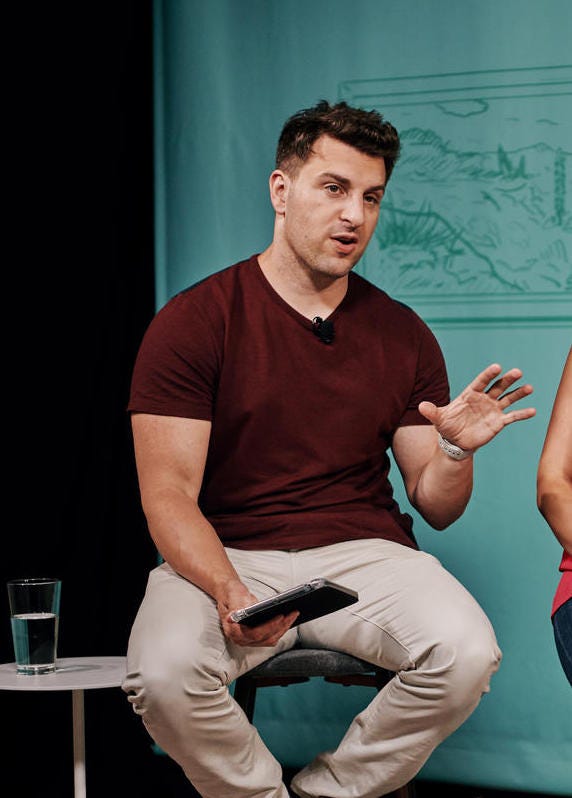
In 2007, roommates Brian Chesky and Joe Gebbia were broke and brainstorming ways to make the upcoming rent payment on their three-bedroom apartment. Chesky and Gebbia had met as students at the Rhode Island School of Design, and when Gebbia moved to San Francisco, he cajoled Chesky to move to the city as well. But the rent was now due, and there were only two of them in a three-bedroom flat.
One idea the pair arrived at was to rent their third bedroom to attendees of a major design conference due to take place soon. Gebbia had three air mattresses available, so the two roommates created a website that offered them to convention attendees for $80/night each. Chesky and Gebbia then started promoting the service, emailing the conference managers, design bloggers, and friends. The tactics worked, and all three air mattresses were rented to conference attendees.
With this initial taste of success, Chesky and Gebbia also attended the conference, not so much as designers but to promote their air bed and breakfast idea. One of their air mattress guests was also in tow and would enthusiastically chime in when Chesky asked him to review his experience thus far. In her book, “The Airbnb Story: How Three Ordinary Guys Disrupted an Industry,” author Leigh Gallagher describes how Chesky, in an after-event gathering at the Fairmont, was able to get into a circle of people surrounding a famous designer, someone he had looked up to for years. Chesky told his hero about the air bed and breakfast business. His hero replied, “Brian, I hope that’s not the only thing you’re working on.” Chesky, crestfallen by the remark, still marvelled that they had made $1,000 from their first hospitality foray.
Despite skepticism from some quarters, Chesky and Gebbia were determined to make a go of the service. They decided to make a more feature-rich site for people attending conferences who might be unable (or want) to stay in a hotel. The South by Southwest event in Austin, TX, would be happening soon, and this would be the perfect opportunity to re-launch the site. Despite their efforts and the new “Finally, an alternative to expensive hotels” tagline, airbedandbreakfast.com received little traction. Only two customers signed up, and one of them was Chesky. But South by Southwest did provide an insight. Some customers asked whether they could use the site to book accommodations for cities they were travelling to but not attending conferences. The answer was no, at least for the time being.

It was now 2008, an election year. The Democratic and Republican National Conventions were about to begin. The DNC was going to be in Denver, and the local papers were forecasting a critical shortage of hotel rooms for convention attendees. The lack of accommodations was perfect news for Chesky’s and Gebbia’s startup. The founders generated so much traffic through relentless promotion that they crashed their website. However, there was a fundamental problem: Air B‘nB did not have the critical mass to create a network effect. In other words, accommodation providers only wanted to list their homes if sufficient guests were on the site — the more guests there were, the more hosts, and vice-versa.
The PR strategy worked, and the little company received a ton of press, resulting in 800 accommodations being registered and 80 guest bookings. Success at last, but it was short-lived. As soon as the convention finished, traffic once again dried up. During this time, the founders and a third partner, Nathan Blecharczyk, applied to Y Combinator, the famous technology incubator in Mountain View, California. In 2009, Y Combinator accepted the trio into their program and invested $20,000 for a 6% stake in the business. Y Combinator had a motto, “Make something people want.”
When Graham asked the Air B‘nB trio how many users they currently had, they replied about one hundred. Graham gave them the first of many strategic insights: it is better to have one hundred users who love you than a million that sort of like you. Graham was also floored by the trio’s reply to his question about where those one hundred users resided. The answer was New York. Yet here were Chesky, Gebbia and Blecharczyk in the middle of Silicon Valley. Graham chided, go to New York; go to where your users are.
The founders moved back to New York and spent hundreds of hours meeting with their users. They saw firsthand how their hosts used their product. Two insights were immediately evident. First, hosts did not understand how to price their accommodations to reflect market conditions. Second, the users were horrendous photographers and regularly uploaded (with difficulty) poor-quality photos that didn’t do their accommodations justice. What looked good in person looked shabby online. The poor photography problem was the easiest to solve. Chesky and Gebbia would show up with their camera to take high-quality photos of the premises and then upload them for the hosts to the site.
The founders also went door to door to introduce the Air B’nB service, held meetups, and promoted the site everywhere they could, one person or one small group at a time. When Barack Obama’s inauguration took place in Washington, DC, later that year, these micro-targeting tactics worked so well in that city that 700 hosts listed their properties, resulting in 150 bookings.
This proximity to their users allowed the founders to realize a few limiting aspects of their business model. One host wanted to know whether he could rent his entire apartment, but the founders said no. The rules at the time required hosts to provide guests breakfast; if the host wasn’t present, how would they do that? However, the request got the founders to re-examine their business model, and they soon removed the need to have air mattresses and provide breakfasts while allowing the rental of an entire suite. These and other changes prompted by their customers provided the first glimmers of traction to solidify, and Air B’nB hit its revenue goal of a solid $1,000 per week. In 2021, Air B’nB had over 8.5 million active listings and booked over 356 million room nights.
Insight and Application
The critical leadership insight in this story is the importance of adaptability and the ability to pivot in response to changing circumstances. Chesky and Gebbia faced numerous challenges as they tried to build their business, including a lack of traction for their initial concept and difficulties scaling their platform. However, they were able to pivot and adapt their business model in response to these challenges, eventually finding success with the model we know today as Airbnb.
This story also illustrates the necessity of a leader’s strong belief in their vision and resilience despite skepticism and criticism. Central to Air B’nB’s success was a customer-centric approach, which was evident in their decision to move closer to their user base in New York. This core move allowed the founders to gain invaluable insights directly from their customers. By actively seeking and responding to user feedback, they were able to adapt their business model effectively — transitioning from offering air mattresses to allowing the rental of entire apartments. This adaptability, rooted in a deep understanding of customer needs, was pivotal in shaping the direction and growth of Airbnb.
Would you do me a favour? Please follow, clap and share the content if you liked it. Thank you!
This is a story in the new book I’m writing, Leadership Parables, which will feature leadership lessons in highly memorable short story form. But I need your help. If you remember an anecdote that influenced the way you think about business and leadership, tell me about it. If your suggestion is selected, you will receive a copy of the book and credit as a contributor. If you would like to know when the book is released, please add your name here. And if you have an idea to share, please contact me at kurian@strategypeak.com.

Also, check out my first book, The 7 Essential Stories Charismatic Leaders Tell, click here: https://amzn.to/2PSHgmB
